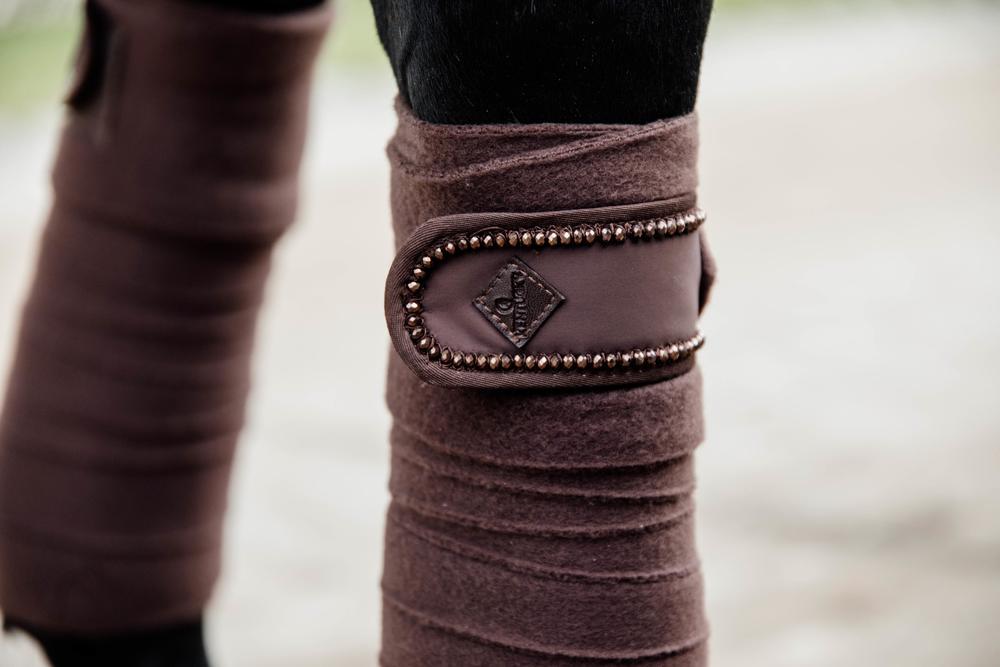
The basics of bandages
Bandages, they look so sophisticated on horses, but putting them on is always something that makes you turn to the boots again. If you’re a little lost in the world of bandages, stable bandages and bandage pads. We’re here to help!
The use of bandages
Bandages can be used for different things: they protect the horse’s legs, reduce swollen legs and offer support. Bandages are used during training to protect the tendons and ligaments. It protects the legs from getting hurt by hoofs, branches or other things on the road. If the horse has small wounds on the legs, bandages protect the wound from getting inflamed. Bandages are used to add some extra style to your look too. Nowadays you have bandages with a velvet or glitter closure. Buying them in a matching set makes the look complete. Bandages can also be used in the stables or during transport. The bandages help the blood flow and avoid fluid from building up in the legs.
Types of bandages
Bandages are made from different types of fabric. Polo bandages and fleece bandages are actually the same. They’re made of the same material, but the closure and the thickness of the material might be different. The higher the g/m2, the warmer and stronger the fleece is. These bandages are used for training. You could use this as stable bandages too, but fleece is known as a sticky material for hay and shavings so it’s better to buy special stable bandages to avoid this.
If you have shavings stuck in your bandages, we’ve also repellent working bandages. These bandages repel shavings and are easier to clean. Other bandages for training are elastic bandages. If you’re using this, it’s very important to always use bandage pads. Elastic bandages are often wrapped around the leg too tightly, a bandage pad prevents this. Nowadays, bandages with a combination of fleece and elastic are available too. The fleece works as the bandage pad, and the elastic offers the leg protection and support. Bandages with elastic can’t be used for stable bandages.
In the stable you can use special stable bandages. These bandages are longer than normal bandages. The bandages go with special stable bandage pads and wrap a larger part of the area. If you prefer another material, you can use wool bandages in the stable or during transport too.
The use of bandage pads
A bandage pad is a piece of fabric that you wrap around the horse’s leg when you want to start bandaging. The pads avoid overheating, pressure marks, and cutting off the legs. the bandage pads divide the pressure evenly and make sure the bandage is not wrapped around the leg too tightly. When you’re using pads during training, it also provides better protection.
Bandage pads come in different sizes and thicknesses. Working bandage pads are thinner than stable bandage pads. Working bandage pads are thinner and smaller to allow the leg to cool down. The fabric used in working bandages absorbs sweat and impact, which is comfortable for the horse during training. The pads ensure that the pressure of the bandage is divided evenly, and the bandage is not too tight. It’s not always necessary to use pads during training but it’s highly advised to do so. Stable bandage pads are thicker and offer a more cushioning effect. This is extremely comfortable during transport or while being stabled. The pads are also very effective to use when the horse is recovering. For an extra fast recovery, you can use our Magnetic Recuptex Bandage Pads.
How to apply bandages
When you’re applying bandages, start with clean and dry legs. If you’re using a bandage pad, apply it to the legs. make sure the end of the pad is on the outside of the leg. While holding the bandage pad in place, take your bandage and place it in the middle of the leg (if you have a smaller horse or a pony, start at the top) on the inside of the leg. If you’re wrapping the right legs wrap clockwise, if you’re wrapping the left legs wrap counterclockwise. Slowly wrap downward with the wrap and make sure there are no wrinkles in the bandage. If you’ve reached the fetlock joint, slowly go up again. Normally the closure of the bandage is on the outside of the leg, when the fabric has finished. Make sure you close the bandage properly and the bandage is not wrinkled or too tight/loose.
The pressure of the bandages must be even on the front and hind legs. If you’re bandaging with a friend, make sure one of you does the front legs and the other the hind legs. by doing this, you’re sure that the bandages are evenly wrapped.
How to wash bandages
Bandages are easy to clean. Close the Velcro to avoid damaging the bandage and having dirt in the fastenings. Put the bandages in a Wash bag. Wash them at 30 degrees and let them air dry. The same goes for the working bandage pads. Washing your stable bandages pads is a little different than the other pad and bandages. After washing them at 30 degrees, you put them in the dryer along with some tennis balls. The tennis balls will give the pads it’s volume back again and distribute the filling of the pads.

